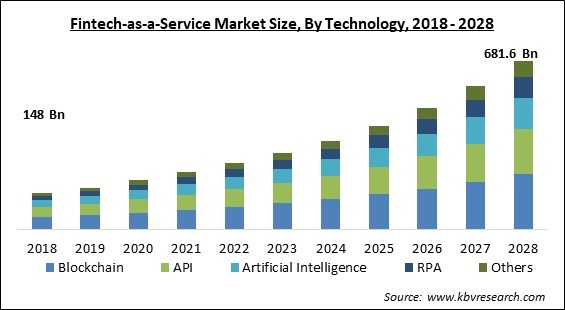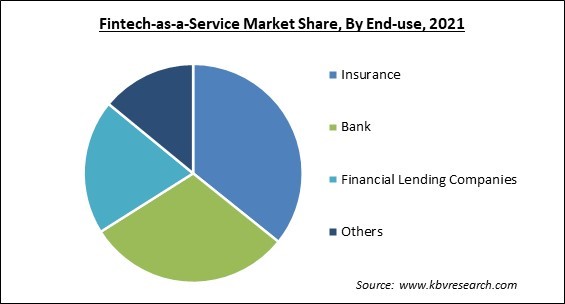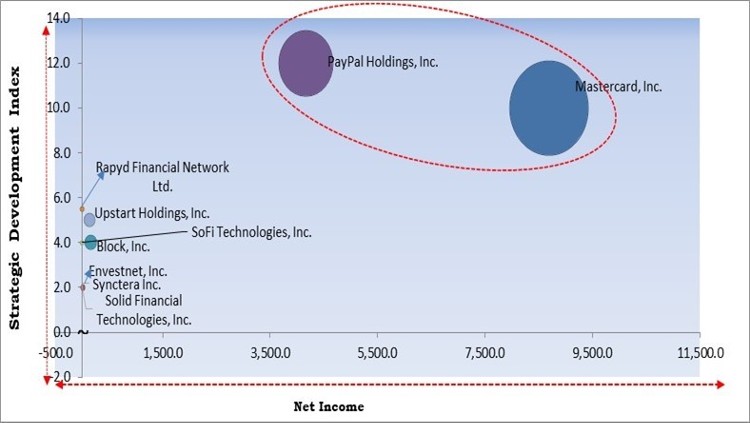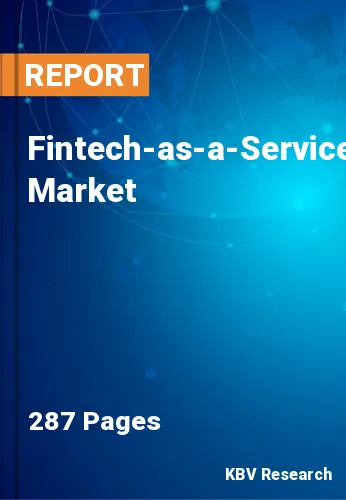The Global Fintech-as-a-Service Market size is expected to reach $681.6 billion by 2028, rising at a market growth of 16.9% CAGR during the forecast period.
The abbreviation for "Financial Technology" is fintech. In essence, it's a piece of software that tries to automate, enhance, and facilitate both the management of financial operations for business owners and the experience of clients utilizing financial services. Even though the phrase is only about ten years old, its popularity trend has long been established. Although it may seem like something that only bankers and techies deal with and comprehend, customers interact with it more frequently than they know.

Tokenization, one-click purchases, cryptocurrencies, and any form of online purchasing, for example, are all members of the large "Fintech services" family. Offering financial technology as a service is referred to as "fintech as a service." The Cashier platform serves as an illustration of this, enabling merchants from various business categories to access a variety of payment options with just a single integration. They provide this platform's access as a service.
The provider of the technology is solely accountable for the platform's creation, upkeep, upgrades, adherence to security requirements, etc. Fintech-as-a-Service is the term for providing financial technology as a service. Offering other participants in the financial industry APIs as software that may be incorporated into their systems may fall under this category. A typical financial platform provides access to different payment options with just one integration for merchants from various business categories.
To take advantage of cutting-edge business activities and financial processes, many traditional lending institutions are turning to fintech technologies. The demand for technology-backed banking has increased as a result of the surge in popularity of digital payments, digital lending, insurance, wealth management, and Robo-advisory.
Financial institutions can streamline all of their procedures by using a Fintech-as-a-Service platform, ensuring the timely and proper delivery of a commercial service over the Internet. FaaS solutions provide total deployment and management of the delivery environment. Additionally, they guarantee the use of relevant security measures, such as strong authentication, and legal compliance with banking regulations.
To provide clients with a safe and secure method of payment, some retail establishments also implemented contactless payments at the same time. The increased use of digital fintech services during the pandemic, such as digital wallets, is positive for the fintech platform as a service. Several nations had negative economic effects as a result of the COVID-19 pandemic because of the shutdown to stop the virus' spread. People used FinTech apps and services to help people negotiate a wide range of financial demands, including banking, pay analyzers, and making payments, among others, as a result of the COVID-19 pandemic's increased financial issues. Due to the lockdown implementation and reluctance to trade currency, payment wallets saw a large increase in P2P transfers, bill payments, and P2M payments for important services.
The demands the Fintech-as-a-Service platform market are driven by the growing use of mobile payment technologies and increased attention to big tech financial services. The current generation has adopted mobile payment technology as a trend. Using a smartphone application, a user can access account information, manage payments, and pay for services using a mobile wallet that is a digital wallet. The widespread use of digital wallets is attributed to the recent increase in smartphone users. As a result, the market for the Fintech-as-a-Service platform ultimately benefits from the development of mobile payment technologies.

Predictive analysis is being used more often in financials. Predictive analytics in the financial services sector can directly affect overall business strategy, revenue generation, sales nurturing, and optimization. It has the potential to change the game by improving internal procedures, business operations, and performance against the competition. Analytics works cooperatively with companies from a variety of industries to gather and organize data, analyze it using state-of-the-art technology and algorithms, and quickly deploy customized, prescriptive solutions to meet the needs of every client. The determination of credit scores and the prevention of troublesome loans can both benefit from predictive analysis.
The biggest barrier to AI adoption in the Fintech-as-a-Service is the delicate subject of data protection and security, which is addressed by the majority of fintech organizations. The fintech industry is closely regulated by strict adherence to standards and governance since any data breach or security failure might be fatal. Businesses are feeding increasingly more user and provider data into sophisticated, AI-powered algorithms, creating novel personal data without being aware of how that would influence customers and staff, which ultimately fuels the escalating privacy concerns.
On the basis of Type, the Fintech-as-a-Service Market is segmented into Payment, Fund Transfer, Loan, and others. The payment segment acquired the highest revenue share in the Fintech-as-a-Service market in 2021. Due to the growing integration of AI technology and API into mobile-based payment services for traditional banking. The creative initiatives being used by numerous tech-based businesses to improve their products are also encouraging for the segment's growth.
Based on the Technology, the Fintech-as-a-Service Market is divided into API, Artificial Intelligence, RPA, Blockchain, and Others. The blockchain segment procured the largest revenue share in the Fintech-as-a-Service market in 2021. Due to its increased transparency and advantages for automation, several significant businesses are attempting to adopt blockchain. Blockchain technology is being embraced by financial organizations due to the improved security and efficiency it provides.
By Application, the Fintech-as-a-Service Market is bifurcated into KYC Verification, Fraud Monitoring, Compliance & Regulatory Support, and Others. The KYC Verification segment witnessed a significant revenue share in the Fintech-as-a-Service market in 2021. Among the key elements anticipated to propel the segment's growth are the rise in criminal activity and the number of scams. KYC is a crucial regulatory component that verifies the veracity of users by validating the personal information they have submitted.
On the basis of End-use, the Fintech-as-a-Service Market is divided into Banks, Financial Lending Companies, Insurance, and Others. The financial lending companies segment recorded a substantial revenue share in the Fintech-as-a-Service market in 2021. It is because consumers increasingly desire to use financial instruments at their convenience from home. Additionally, technologically advanced platforms assist financial organizations in providing services like borrowing, lending, fixed deposits, and others. Additionally, the increasing use of digital lending platforms is positive for the market's expansion.
| Report Attribute | Details |
|---|---|
| Market size value in 2021 | USD 230.7 Billion |
| Market size forecast in 2028 | USD 681.6 Billion |
| Base Year | 2021 |
| Historical Period | 2018 to 2020 |
| Forecast Period | 2022 to 2028 |
| Revenue Growth Rate | CAGR of 16.9% from 2022 to 2028 |
| Number of Pages | 287 |
| Number of Tables | 494 |
| Report coverage | Market Trends, Revenue Estimation and Forecast, Segmentation Analysis, Regional and Country Breakdown, Competitive Landscape, Companies Strategic Developments, Company Profiling |
| Segments covered | Technology, Type, Application, End Use, Region |
| Country scope | US, Canada, Mexico, Germany, UK, France, Russia, Spain, Italy, China, Japan, India, South Korea, Singapore, Malaysia, Brazil, Argentina, UAE, Saudi Arabia, South Africa, Nigeria |
| Growth Drivers |
|
| Restraints |
|
Region-wise, the Fintech-as-a-Service Market is analyzed across North America, Europe, Asia Pacific, and LAMEA. The North America region procured the highest revenue share in the Fintech-as-a-Service in 2021. It is because of North America's increasing preference for digital financial services. For instance, 51% of customers in the United States use a contactless payment method, according to MasterCard Contactless Consumer Polling. The industry is expanding due to the shifting customer preferences toward fintech services and digital payment methods. Factors that can be attributed to the region's increasing adoption of smartphones.
Free Valuable Insights: Global Fintech-as-a-Service Market size to reach USD 681.6 Billion by 2028

The major strategies followed by the market participants are Partnerships. Based on the Analysis presented in the Cardinal matrix; PayPal Holdings, Inc. and Mastercard, Inc. are the forerunners in the Fintech-as-a-Service Market. Companies such as Rapyd Financial Network Ltd., Upstart Holdings, Inc., Block, Inc. are some of the key innovators in Fintech-as-a-Service Market.
The market research report covers the analysis of key stake holders of the market. Key companies profiled in the report include PayPal Holdings, Inc., Mastercard, Inc., Upstart Network, Inc., Block, Inc., Envestnet, Inc., SoFi Technologies, Inc., Rapyd Financial Network Ltd., Solid Financial Technologies, Inc., Synctera Inc., and Railsbank Technology Ltd. (Railsr).
By Technology
By End Use
By Type
By Application
By Geography
The global Fintech-as-a-Service Market size is expected to reach $681.6 billion by 2028.
The Utilization Of Mobile Banking Is Expanding are driving the market in coming years, however, Worries Regarding Data Security And Privacy restraints the growth of the market.
PayPal Holdings, Inc., Mastercard, Inc., Upstart Network, Inc., Block, Inc., Envestnet, Inc., SoFi Technologies, Inc., Rapyd Financial Network Ltd., Solid Financial Technologies, Inc., Synctera Inc., and Railsbank Technology Ltd. (Railsr).
The expected CAGR of the Fintech-as-a-Service Market is 16.9% from 2022 to 2028.
The Insurance segment acquired maximum revenue share in the Global Fintech-as-a-Service Market by End-use in 2021 thereby, achieving a market value of $240.6 billion by 2028.
The North America market dominated the Global Fintech-as-a-Service Market by Region in 2021, and would continue to be a dominant market till 2028; thereby, achieving a market value of $229.8 billion by 2028.
Our team of dedicated experts can provide you with attractive expansion opportunities for your business.

